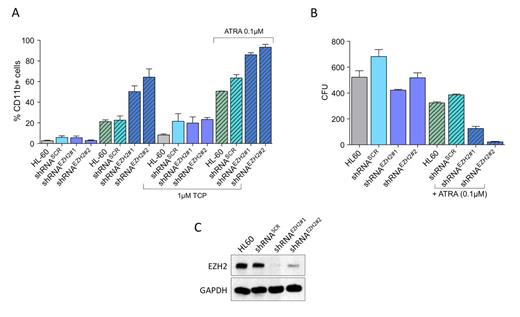Abstract
The histone methyltransferase Enhancer of Zeste Homologue 2 (EZH2), a component of the polycomb group complex, is critical for normal hematopoietic stem cell development. EZH2 mediates transcriptional repression through histone tri-methylation (H3K27me3). The activity of EZH2 influences cell fate regulation, namely the balance between self-renewal and differentiation. The contribution of aberrant EZH2 expression to tumorigenesis is becoming increasingly recognized. Its role in hematological malignancies however, is complex. Both gain-of-function and loss-of-function mutations have been respectively reported in lymphoma and leukemia, suggesting that EZH2 may serve a dual purpose as an oncogene and tumor-suppressor gene. Impaired self-renewal via EZH2 inhibition has been observed and offers a potentially attractive therapeutic approach in acute myeloid leukemia. Indeed, overexpression of EZH2 has been reported in patients with AML, particularly in those with complex karyotypes.
In the present study, we show that deletion of EZH2 compromises the growth potential of AML cells by promoting their differentiation. To understand the role of EZH2 in vitro, we first examined the cell growth and colony-forming ability of EZH2 knockdown vs WT HL-60 cells. We found that proliferation of HL-60 cells was severely compromised following deletion of EZH2. Additionally, EZH2 deletion resulted in retarded cell-cycle entry and resulted in increased apoptotic cell death Similarly, the number of total colonies generated by EZH2 deleted cells in the secondary and tertiary re-plating assays was considerably less than that of controls. EZH2 deleted cells tended to form dispersed colonies that were mainly composed of differentiated myeloid cells, whereas control cells mostly formed compact colonies composed of myeloblasts. The proportion of dispersed colonies in the EZH2deleted cell culture increased with serial replatings. Deletion of EZH2 affects the growth and replating capacity of AML cell in vitro. When EZH2 deleted HL-60 cells were treated with the retinoid all-trans-retinoic acid (ATRA), we observed a marked induction of differentiation (as measured by the myeloid maturation marker CD11b) compared to the effects of ATRA on differentiation in wild type (WT) cells. Similarly, impaired clonogenic survival was more pronounced following ATRA treatment in EZH2 deleted vs WT HL-60 cells (see figure). We then profiled a number of small molecule inhibitors of EZH2 alone (EPZ005687, EPZ-6438, GSK126, El1, DZNeP, UNC1999 and GSK343) and in combination with ATRA, confirming these phenotypic changes. To elucidate the mechanism for how EZH2 regulates the balance of self-renewal vs differentiation in AML, we examined the genome-wide distribution of H3K27me3 by ChIP-seq analysis. First, western blot analysis revealed a marked decrease in the levels of H3K27me3 in EZH2 deleted AML cells. Next, we examined the presence of H3K27me3 marks in leukemia cells purified by ChIP-seq analysis. We focused on the region from 5.0 kb upstream to 3.0 kb downstream of transcription start sites (TSSs) of reference sequence (RefSeq) genes (http://www.ncbi.nlm.nih.gov/RefSeq/) because H3K27me3 marks are usually enriched near TSSs or across the body of genes. As expected, the deletion of EZH2 caused a drastic reduction in these H3K27me3 marks.
Targeting EZH2 presents and interesting dichotomy as a novel drug target since inhibition of this protein could potentially be beneficial or detrimental depending on the context of the disease. In the case of AML, EZH2 mutations likely impede differentiation and block retinoic acid led differentiation programs. Updated studies outlining the interaction between the retinoic acid signaling pathway and EZH2 will be presented. These studies justify clinical investigation of EZH2 inhibitors combined with ATRA for patients with AML.
Knockdown of EZH2 (C) promotes differentiation of AML cells (A), impairs clonogenic survival and synergistically enhances the anti-leukemic effects of the retinoid all-trans-retinoic acid (ATRA) (B).
Knockdown of EZH2 (C) promotes differentiation of AML cells (A), impairs clonogenic survival and synergistically enhances the anti-leukemic effects of the retinoid all-trans-retinoic acid (ATRA) (B).
No relevant conflicts of interest to declare.
Author notes
Asterisk with author names denotes non-ASH members.


This feature is available to Subscribers Only
Sign In or Create an Account Close Modal